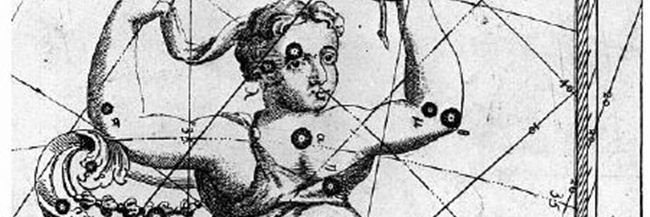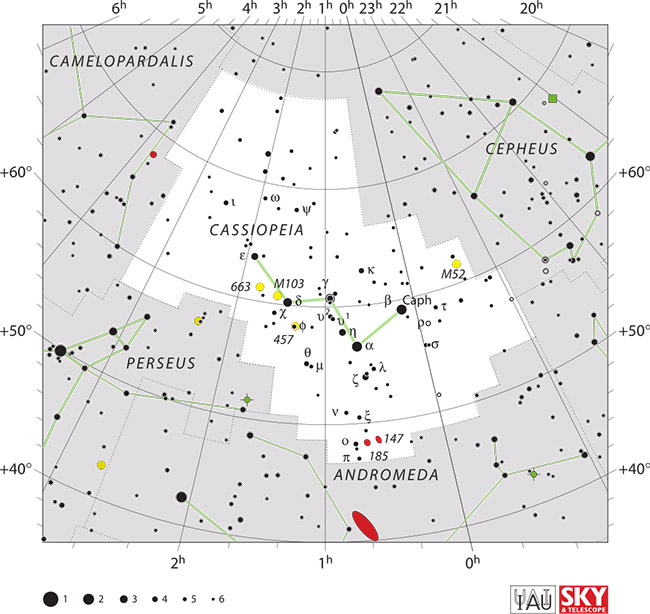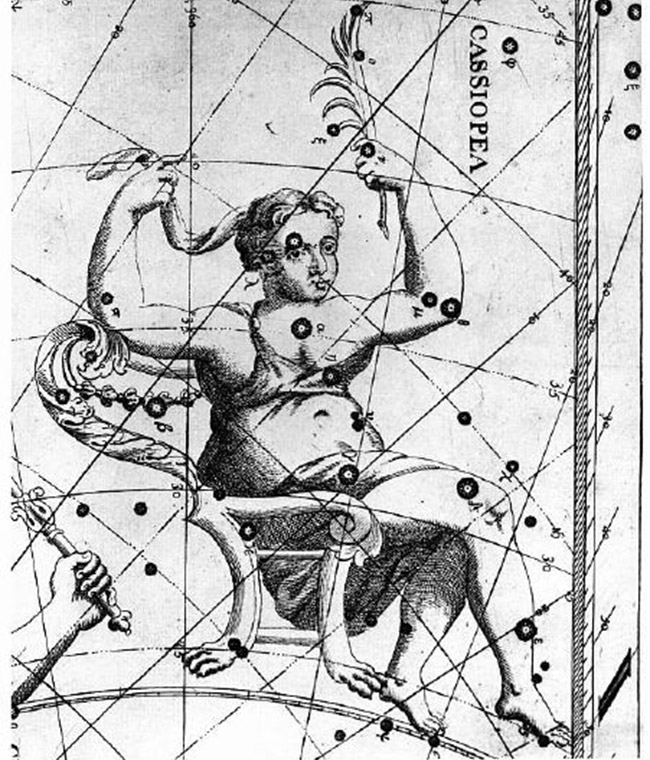Cassiopeia – Constellation Facts

Cassiopeia is named after the Queen in Greek mythology who was very vain, arrogant and boastful. This constellation can be located in the first quadrant of the Northern hemisphere and is located specifically between latitudes of +90° and -20°. Cassiopeia was first catalogued in the 2nd century by, Ptolemy, a Greek astronomer.
Constellation Characteristics
The characteristic “W’ shape of Cassiopeia is the 25th largest constellation in the night sky, occupying 598 square degrees. Cassiopeia is also neighbors with Andromeda, Camelopardalis, Cepheus, Lacerta and Perseus. In addition, this constellation has nine stars, eight deep space objects and also one meteor shower; Perseid meteor shower.

IAU and Sky & Telescope magazine (Roger Sinnott & Rick Fienberg), CC BY 3.0, via Wikimedia Commons
By IAU and Sky & Telescope magazine (Roger Sinnott & Rick Fienberg) CC BY 3.0, via Wikimedia CommonsPlanetary Systems
Cassiopeia has seven deep sky objects. Read on to discover some fascinating facts about these celestial wonders.
- Messier 52 (NGC 7654): first discovered in 1774, this open cluster is estimated to be about 35 million years-old and contains (among others) two bright giants that shine the brightest.
- Messier 103 (NGC 581): this 25 million year-old open cluster contains around 172 stars and is about 10,000 light-years from here.
- Cassiopeia A: this deep space wonder is the remnants from a supernova and burns at around 50 million degrees Fahrenheit. It is also known for being one of the first and also the brightest and strongest astronomical radio forces.
- The Pacman Nebula (NGC 281): named after its resemblance to the popular video game character, NGC 281 is a large gas cloud with recent star formations.
- The White Rose Cluster (NGC 7789): because of the star-pattern-loops that resemble rose petals, this open star cluster is also called, “Caroline’s Rose” or “the White Rose.”
- NGC 185 (Caldwell 18): this dwarf spheroidal galaxy contains young clusters of stars and, until recently, has shown star formation. It is located 2.08 million light-years in distance.
- NGC 147 (Caldwell 17): this is another dwarf spheroidal galaxy. It can be found 2.53 million light-years from Earth.
Main Stars
The constellation Cassiopeia contains nine main stars that makes up its shape. Let’s explore them further.
- Gamma Cassiopeiae shines the brightest in the Cassiopeia constellation (which will be discussed later in detail).
- Schedar (Shedir) ~ (Alpha Cassiopeiae) is located at the bottom-right of Cassiopeia’s “W.” Its name is from the Arabic language (sadr) which means “breast” and marks the place of Cassiopeia’s heart. This star is categorized as a orange giant and is located about 228 light-years away.
- Caph (Beta Cassiopeiae) derives its name from the Arabic language (kaf) which means “palm.” This star is known as one of the Three Guides (the other two are Alpheratz in Andromeda and Algenib in Pegasus) that marks the point where the Sun crosses the celestial equator into the Spring and Autumn equinox.
- Ruchbah (Delta Cassiopeiae) is another name derived from the Arabic language (rukbah) which means knee. It is known as an eclipsing binary star and is the fourth most luminous in this constellation.
- Segin (Epsilon Cassiopeiae) is thought to be around 65 million years-old. It is a bright blue-white B-class giant that is located about 440 light-years away.
- Achird (Eta Cassiopeiae) is a yellow-white G-class hydrogen fusing dwarf, with a dimmer orange K-class dwarf. It is the closest star in Cassiopeia to Earth at only 19.4 light-years distance.
- Zeta Cassiopeiae is a Slow Pulsating B star that was discovered to have a magnetic field and is located around 600 light-years away.
- Rho Cassiopeiae is a rare yellow supergiant (only seven are known in the Milky Way). It is 550,000 times more luminous than the Sun and has regular “outbursts” every 50 years, where it can expel large amounts of debris, which changes its brightness.
- V509 Cassiopeiae is located 7,800 light-years away and is categorized as a G-type hypergiant.

Cassiopeia the vainglorious queen seated on her throne, depicted in the Atlas Coelestis of John Flamsteed (1729)
Cassiopeia the vainglorious queen seated on her throne, depicted in the Atlas Coelestis of John Flamsteed (1729)Most Shining Star
Out of all the stars that make up the Cassiopeia constellation, none shine brighter than Gamma Cassiopeiae. This star is located 610 light-years away and is the star situated in the central part of the W-shape. This blue star shines 40,000 time brighter than the Sun and is a known X-ray source. The Chinese call this star, Tsih, which means “the whip.”
Mythology & History
Cassiopeia, in mythology, was married to the King of Ethiopia (Cepheus; also a constellation). One day Cassiopeia bragged to the sea nymphs of her beauty being higher than them all. The nymphs were outraged and in retaliation asked Poseidon to punish the arrogant Queen. Poseidon being married to one of the sea nymph was happy to oblige and summoned a sea monster (Cetus the Whale) to ravage the land.
When the water came, Cepheus turned to a oracle for help. It told him he and Cassiopeia would have to sacrifice their daughter, Andromeda, to appease the sea monster. Cepheus obliged and chained Andromeda to a stone; however, before the monster could take her Perseus rescued her and they were later married.
As the story goes, Phineas (a former lover of Andromeda) attended the wedding in order to claim Andromeda. He was outnumbered and in the battle used Medusa’s head to turn his opponents into stone. In the haste and fooliness, Cassiopeia and the King looked at the head and were instantly turned to stone. Poseidon then placed both the Queen and King into the sky, where Cassiopeia was forever condemned to circle the celestial pole, spending half of the year upside down for her arrogance and vanity.
Cassiopeia is a fascinating constellation, so the next time you are gazing into the night sky, be sure to search out this intriguing figuration of stars.
